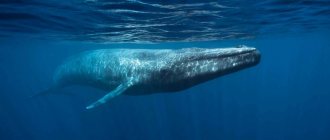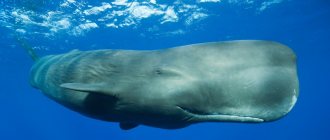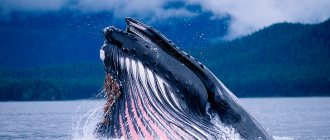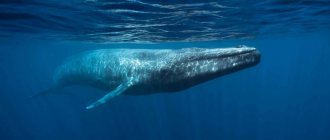- Wild animals
- >>
- Mammals
The blue whale (vomit) is the most massive inhabitant of our planet. It weighs up to 170 tons, and its length can be up to 30 meters. Only a few representatives of this species grow to such sizes, but the rest can also justifiably be called giants. Due to active extermination, the population of vomits has greatly decreased, and now they are in danger of extinction.
Origin of the species and description
Photo: Blue whale
Whales, like all other cetaceans, are not fish, but mammals, and descended from land artiodactyls. Their external similarity with fish is the result of convergent evolution, in which organisms living in similar conditions, initially very different from each other, acquire more and more similar features over time.
Of the other modern animals, the closest thing to whales is not fish, but hippopotamuses. More than 50 million years have passed since their common ancestor lived on the planet - he lived on land. Then one of the species descended from it moved into the sea and gave rise to cetaceans.
Video: Blue whale
The scientific description of the vomiting whale was first given by R. Sibbald in 1694, and therefore it was called Sibbald's minke whale for a long time. The now accepted name in Latin, Balaenoptera musculus, was given by C. Linnaeus in 1758. The first part of it is translated as “whale-winged”, and the second - “muscular” or “mouse”.
For a long time, the blue whale was hardly studied, and scientists had little idea even of what it looked like: the drawings in biological reference books of the century before last were incorrect. Only towards the end of the century did the species begin to be systematically studied, and then its modern name, that is, “blue whale,” began to be used.
This species includes three subspecies:
- dwarf blue whale;
- northern;
- southern.
They differ quite little from each other. Dwarf vomits live in the warm Indian Ocean, while representatives of the other two subspecies love colder water and migrate to the Arctic or Antarctic in the summer. Northern vomits are considered the type subspecies, but southern ones are more numerous and larger.
The internal organs were vomited to match the size of his torso - for example, his heart weighs 3 tons. And in the mouth of this whale a medium-sized room could fit.
Whales and hippos shared common ancestors
The distant ancestors of whales were land animals that walked on four legs. Then they went to the ocean in search of more accessible and plentiful food. At first, the ancestors of whales - Pakicetus - hunted fish in shallow waters and returned to the shore to rest. But competition forced the animals to swim further and further into the depths of the ancient ocean, and the opportunity to return to land disappeared.
Molecular genetic data indicate that cetaceans are close relatives of artiodactyls, in particular hippopotamuses.
Appearance and features
Photo: Animal blue whale
The skin is gray with spots. The shade of the back and sides is slightly lighter, and the head, on the contrary, is darker. The belly is distinctly yellowish, which is why the vomit was previously called the yellow-bellied whale. The animal's modern name was given because its back may appear blue when viewed through seawater.
The skin is mostly smooth, but there are stripes along the stomach and throat. Many different parasites live on the animal’s skin and baleen. The eyes are small in relation to the body - only 10 centimeters in diameter, located at the edges of the head, which is shaped like a horseshoe.
The jaw is arched and protrudes forward by about 20 centimeters when the mouth is closed. Whales are warm-blooded, and an impressive layer of fat is designed to help maintain temperature.
There are no gills, vomits breathe with the help of powerful lungs: almost complete air exchange can be carried out at a time - 90% (for comparison: a person needs to take six inhalations and exhalations to achieve this figure).
Due to the volume of their lungs, whales can remain in the depths for up to 40 minutes before needing more air. When a whale rises to the surface and exhales, a fountain of warm air appears, and the sound produced by this can be heard from afar - 3-4 kilometers away.
In total, there are several hundred whalebone plates measuring 100 by 30 centimeters in the animal’s mouth. With the help of plates, the whale vomits water, and the fringe with which they end filters plankton from it, which the whale feeds on.
Range, habitats
Gone are the days when the blue whale frolicked throughout the vastness of the world's oceans. Nowadays, the range of the vomit is fragmented and extends from the Chukchi Sea and the shores of Greenland, across Novaya Zemlya and Spitsbergen to the Antarctic itself. The great northern minke whale, a rare guest of the tropical zone, goes to winter in the warm seas of the Northern Hemisphere (near Taiwan, Southern Japan, Mexico, California, North Africa and the Caribbean), as well as the Southern Hemisphere (near Australia, Ecuador, Peru, Madagascar and South Africa).
In summer, the blue whale rests in the waters of the North Atlantic, Antarctica, Chukchi and Bering seas.
Return to content
Where does the blue whale live?
Photo: Great blue whale
Previously, it was possible to meet vomiters in various parts of the world, but then their total numbers decreased significantly, and their habitat became fragmented. There are several zones in which this animal can now be found most often.
In summer, this is a belt of Arctic and Antarctic water bodies. In winter they travel closer to the equator. But they don’t like too warm water, and they almost never swim to the equator itself, even during migrations. But dwarf vomits live in the warm waters of the Indian Ocean all year round - they do not swim to the cold seas at all.
The migratory routes of vomits are still not fully understood, and we can only note where their presence has been recorded. The winter migration itself remained unexplained for a long time, because the food supply in the Arctic and Antarctic seas remains the same in winter. The most common explanation today is that this is required for cubs whose fat layer is insufficient to remain in cold waters in winter.
The most numerous groups of vomits are in the Southern Hemisphere; in the Northern Hemisphere they are found much less frequently, but sometimes they swim to the shores of Portugal and Spain, they were even met off the Greek coast, although they usually do not swim into the Mediterranean Sea. They can rarely be found off the coast of Russia.
Whale populations are distinguished (also called herds) - they almost do not mix with representatives of other populations, even if their habitats overlap. In the northern seas, researchers identify 9 or 10 populations; there is no such data regarding the southern seas.
Lifestyle
Blue whales lead an isolated lifestyle. They often swim alone. But it happens that they gather in small herds. The animal's main activity is carried out during the day. To communicate with their fellow whales, whales use infrasound signals. They can spread them over fairly long distances (maximum 33 kilometers).
In places where there is an abundance of food, whales gather in schools. The herd can number up to 60 animals. Being in a school with its fellows, the whale always stays apart.
A blue whale can dive into the water for about five hundred meters and stay there for a maximum of fifty minutes. When obtaining food, it dives into the water column to 200 meters with a frequency of 6-19 minutes. Having emerged, it always emits a water fountain.
When moving, a blue whale can reach a top speed of about 48 km/h. While feeding, the animal does not move very quickly (2-6 km/h).
What does the blue whale eat?
Photo: Sea blue whale
Their menu consists of:
- plankton;
- fish;
- squid
The diet is not rich, and the diet is based on plankton, consisting mainly of krill. Depending on the region, these may be different types of crustaceans. As for fish, according to most cetologists (that’s what specialists who study cetaceans are called), it ends up on a whale’s menu only by accident, getting there when swallowing crustaceans; the whale does not eat it on purpose.
Some cetologists, however, believe that if the blue whale does not find large enough accumulations of plankton to satisfy its appetite, then it quite consciously swims up to schools of small fish and swallows them. The same thing happens with squid.
In any case, it is plankton that dominates the diet of a puking whale: the animal finds its accumulations, swims straight into them at a fairly high speed and absorbs tens of tons of water into its open mouth at once. When feeding, a lot of energy is spent, and therefore the whale needs to look for large accumulations of food - it does not react to small ones.
To be completely satiated, a blue whale needs to absorb 1-1.5 tons of food. In total, 3-4 tons are needed per day - for this, the animal filters a huge amount of water. To feed, it dives to a depth of 80-150 meters - such dives are undertaken regularly.
He vomited even more than the largest dinosaurs, the weight of which is approximately determined by scientists. A specimen was recorded weighing 173 tons, which is 65 tons more than the estimated mass of the largest dinosaur.
Nutrition
Whales feed by diving every 10-20 minutes to a depth of about 100 meters. The stomach can hold about one ton of krill at a time. Its requirement for krill is about 4 tons daily during the summer feeding season.
In the mouth there is a so-called “whalebone” of black color. These are horny plates hanging from the upper palate, 300-400 pieces each. from each side. The length of the plates ranges from 50 cm in front to 100 cm in the back. To feed, the animals straighten the “whalebone” in their throats and take in water with krill, sifting it through the horny plates. The water is then released through the baleen and the remaining krill in the mouth is swallowed.
Features of character and lifestyle
Photo: Blue whale in the ocean
They often swim alone, and sometimes in twos or threes. In areas rich in plankton, several such groups can gather. But even if the whales are huddled in a group, they still behave detachedly, and after a while they disperse.
You won’t find them close to the shore - they love vast space and depth. They spend most of their time calmly swimming from one accumulation of plankton to another - this can be compared to how land herbivores graze.
On average, a blue whale swims at a speed of about 10 km/h, but can swim even faster - if it is frightened by something, it reaches 25-30 km/h, but only for a short time, since during such a race it spends a lot of energy .
The process of immersion for nutrition is interesting - it requires preparation. First, the whale empties its lungs, then takes a deep breath, dives shallowly about ten times and comes to the surface again, and only then performs a deep and long dive.
Usually the vomit goes into the depths of the water a hundred or two meters, but if it is frightened, it can dive much deeper - up to half a kilometer. This happens when killer whales hunt him. After 8-20 minutes, the whale surfaces and begins to breathe rapidly, releasing fountains into the air.
After “catching his breath” for a few minutes, he can dive again. If a whale is being pursued, it can remain in the water column much longer, up to 40-50 minutes, but gradually loses strength.
Whales can drown while sleeping
Whales can stay awake for three months if necessary.
And if they fall asleep, then only at a shallow depth near the surface of the water. Their weight, due to the high content of light adipose tissue in the body, slightly exceeds the specific gravity of water. Therefore, the sleeping whale sinks down very slowly. From time to time, the animal hits its tail in its sleep and rises to the surface. Then, after inhaling air, it slowly and passively sinks until the next blow with its tail.
Photo: www.globallookpress.com
Social structure and reproduction
Photo: Blue whale calf
To communicate with other whales, powerful infrasound signals with a frequency of about 10-20 Hz are used. With their help, vomits can make themselves known to relatives swimming at a considerable distance.
These animals are monogamous, and established pairs swim together for many years. Once every two years, a baby whale appears in such pairs; before this, the female carries it for almost a year. A newborn is fed very high-fat milk for a little more than six months, and on a milk diet gains hundreds of kilograms every day.
As a result, it very quickly grows to impressive sizes, reaching 20 tons or even more weight. They are fertile from the age of 4-5, but even after this period the growth process continues - it continues until they are 15 years old.
Researchers' opinions on the life expectancy of vomiting whales vary. The minimum estimate is 40 years, but according to other sources they live twice as long, and long-livers even exceed a hundred years. Which estimate is closer to the truth has not yet been established for certain.
Vomits are the loudest living creatures. They are even louder than an airplane jet engine! Relatives can hear their songs at a distance of hundreds and even thousands of kilometers.
Physical Description
The upper part of the whale is a mottled blue-gray color, while the lower part is light gray or yellow-white. The yellowish tint of the animal's abdominal part is given by growths of microscopic unicellular seaweeds called diatoms. These plants are common in cold sea waters.
It is officially believed that the largest individual was a female, which was caught by whalers in the last century, 23 m 58 cm long. These animals can weigh up to 200 tons. For comparison, the weight of an African elephant is 7.5 tons. The heart of a blue whale is the size of a car, the beats of which can be heard 3 kilometers away . One of the species is the pygmy blue whale. They are three meters shorter than their larger relatives.
These animals have one incomparable quality: blue whales are the loudest animals on earth. The volume of their call signs reaches 188 decibels, which is significantly higher than the sound of a jet engine - 140 decibels. An animal can hear the song of a relative at a distance exceeding 1.5 thousand km.
Interesting facts about polar bears293494.711
In addition to their enormous size, the distinctive features of blue whales are a relatively small dorsal fin, a rounded part of the front of the skull and about 90 longitudinal grooves on the belly, reaching the navel.
Natural enemies of blue whales
Photo: Blue whale
Due to their large size, only killer whales hunt them. What they like best is the language of the whale. But they also attack only young or sick whales - an attempt to hunt a healthy one, with all its clumsiness, will not lead to anything good - the difference in mass is too great.
Even so, in order to defeat a whale, killer whales have to act in a group, sometimes of dozens of individuals. During the hunt, killer whales try to drive the prey into the water column, preventing them from rising and replenishing their air supply. As it ends, the whale weakens and resists more and more sluggishly, while killer whales are able to stay in the water longer. They attack the whale from different sides, tear off pieces from its body and thus weaken it, and then kill it.
But the damage caused by killer whales is not comparable to that inflicted on blue whales by humans, which is why humans could, without exaggeration, be called their main enemy, even to the point of banning fishing. It is because of active whaling that vomits are endangered. From one such whale you can get 25-30 tons of blubber, valuable whalebone, from which many products were made, from brushes and corsets to carriage bodies and chairs, and their meat has high taste.
The extermination of the blue whale began after the advent of the harpoon cannon in the second half of the century before last, after which it became possible to hunt it much more efficiently. Its rate increased after humans nearly exterminated the humpback whale, and the blue became a new source of blubber and baleen. Commercial production of vomit was stopped only in 1966.
How has the WSA humpback whale population recovered?
First, commercial whaling was finally made illegal in 1986; in addition, various government protection measures, the creation of whale sanctuaries, and new regulations governing the whale trade also helped the "population" recover.
Coincidentally or not: why Lady Di put a necklace on her head, which upset the queen
“Creativity and Creativity”: Rosobrnadzor is thinking about transforming the Unified State Exam
Capcom changed team and restarted development of Resident Evil 4 remake
Population and species status
Photo: Animal blue whale
Before the extermination by humans, the population grew to hundreds of thousands - according to various estimates, from 200,000 to 600,000 individuals. But due to intensive hunting, the number of vomits has greatly decreased. Exactly how many of them there are on the planet right now is a complex question, and researchers’ estimates vary greatly depending on the calculation method used.
A minimum estimate suggests that there are from 1,300 to 2,000 blue whales on the planet, of which about 300 to 600 animals live in the northern seas. More optimistic researchers give figures of 3,000–4,000 for the northern seas and 6,000–10,000 for the southern seas.
In any case, their population has been severely undermined, as a result of which the vomit whales have been given the status of an endangered species (EN) and are under protection. Industrial fishing is strictly prohibited, and poaching is also suppressed - punishments for notorious poachers have had an effect, and now cases of illegal fishing of blue whales are rare.
Despite this, they are still under threat, and their population is recovering slowly due to the difficulty of reproduction and some other factors:
- ocean water pollution;
- increasing the number of long, flowing networks;
- collisions with ships.
All these are significant problems, for example, in the population of whales studied by scientists, 9% were found to have scars from collisions with ships, and 12% had marks from nets. However, in recent years, a slight increase in the number of blue whales has been recorded, which gives hope for the conservation of this species.
But the population is growing very slowly. In addition to the problems listed above, the reason is also that the niche was occupied by smaller whales, southern minke whales. People did not pay attention to them, which is why they multiplied and now eat large accumulations of krill before the slower and clumsier vomits get to them.
The blue whale's brain is very small compared to other organs - it weighs only 7 kilograms. At the same time, whales, like dolphins, are smart animals; they are distinguished by high auditory abilities. Scientists believe that they are able to send and receive images through sound, and their brain processes 20 times more information than a human.
Population today
Intensive hunting has led to a severe decline in the number of blue whales. Researchers estimate that there are only about 2,000 individuals left on Earth. There are 600 individuals living in the sea waters of the north. The blue whale or vomit whale is considered an endangered species. Today, catching blue whales is strictly prohibited.
Slow population reproduction is complemented by the following factors:
In recent years there has been a slight increase in the population. This gives us hope that the species will be preserved. In addition to the above reasons, there is one more: the reproduction of small southern whales. They outpace the huge, clumsy whales and eat large accumulations of plankton before the giants get to them.
Features of whalebone
Like all baleen whales, the blue whale has several hundred pairs of baleen plates inside its mouth, consisting of a horny substance (keratin). The length of the baleen plates of the blue whale ranges from 90 cm to a meter, the plates reach their greatest length in the rear rows, closer to the front of the mouth their length gradually decreases to half a meter, the width of the plates is about 50-53 cm.
The weight of one large baleen plate of a blue whale can be up to 90 kg, which is more than that of other minke whales, but less than that of right whales. There are from 260 to 400 plates on each side of the blue whale's upper jaw, so it has a total of 540-790 plates, sometimes over 800.
The blue whale's baleen is completely black, “tar” in color. Like other baleen whales, the blue whale's baleen plates are roughly triangular in shape, pointing downwards, with the inner side and top of the plate frayed into a hair-like fringe. In the blue whale, the fringe on the baleen plates is quite coarse and rigid, which is an adaptive feature for feeding on relatively large crustaceans, while right whales, which consume very small planktonic crustaceans, have a thin and elastic fringe.











